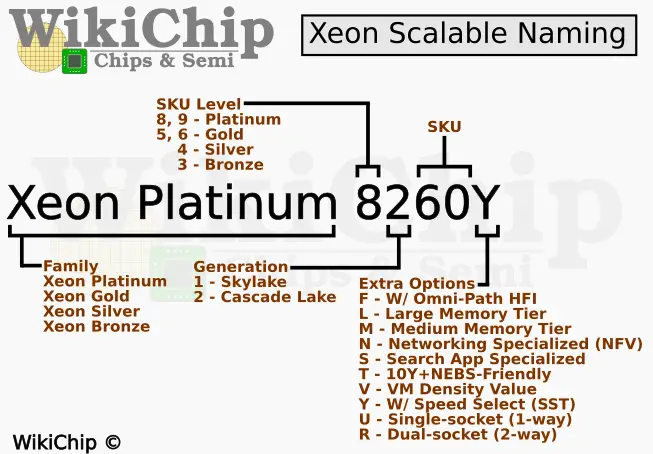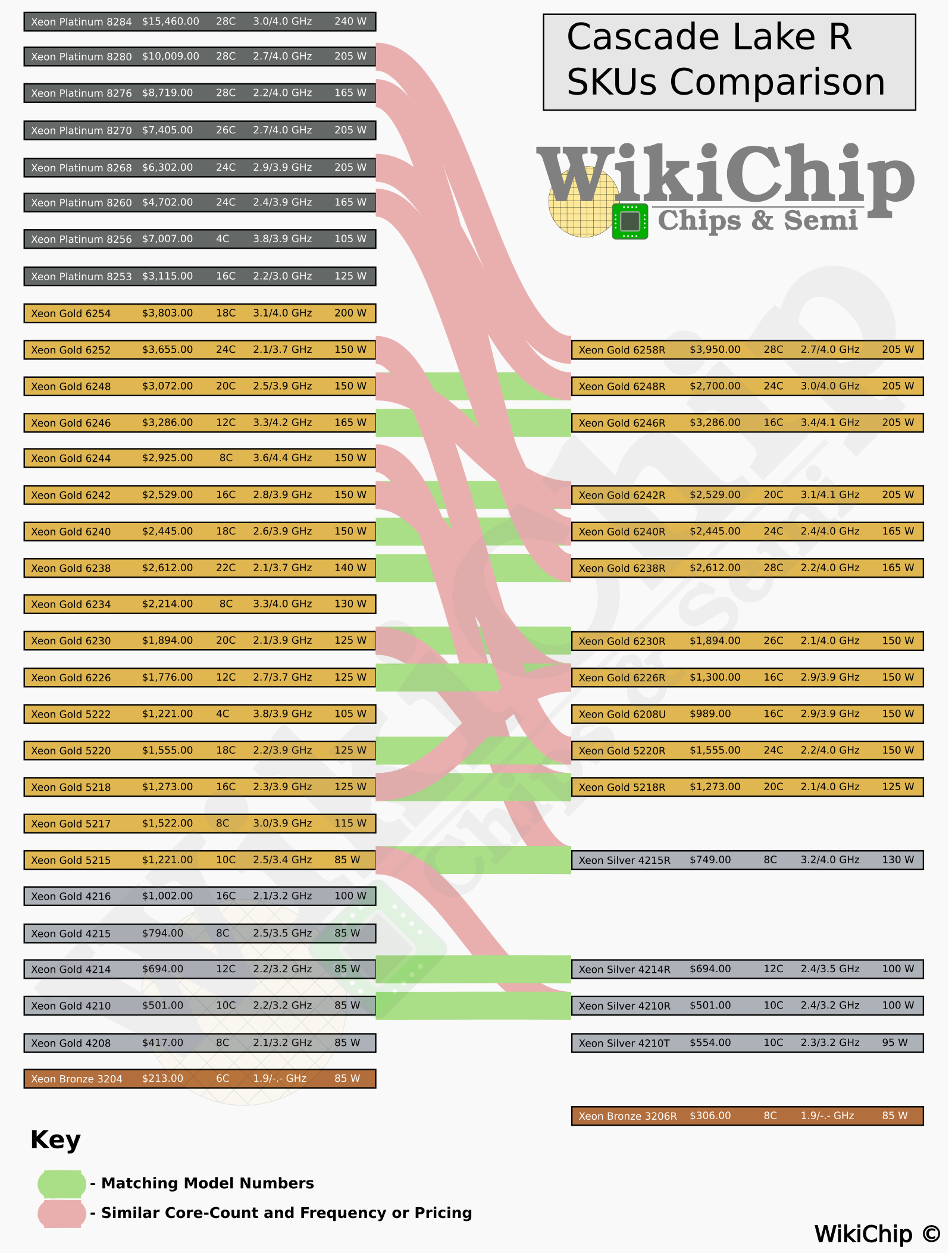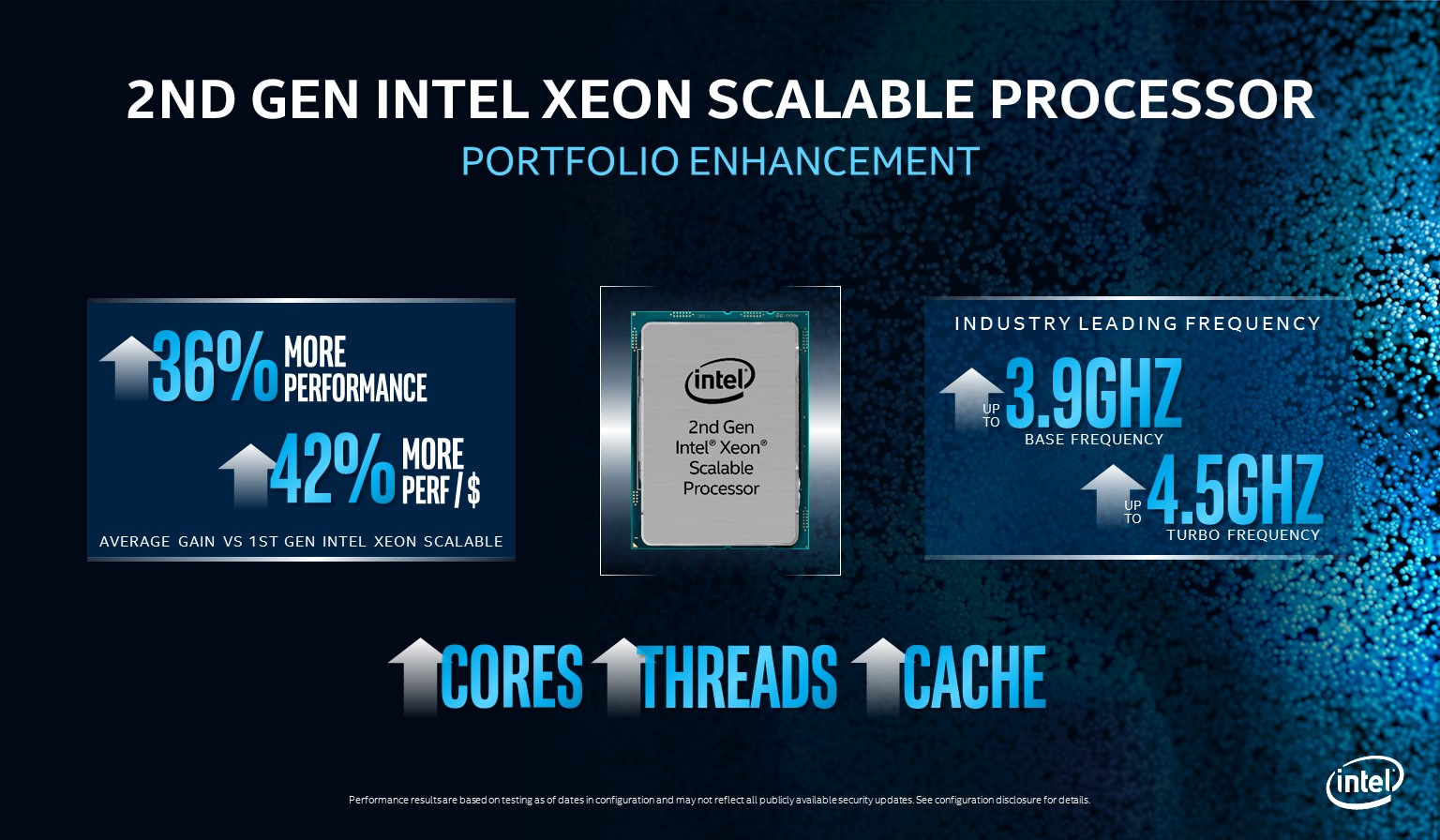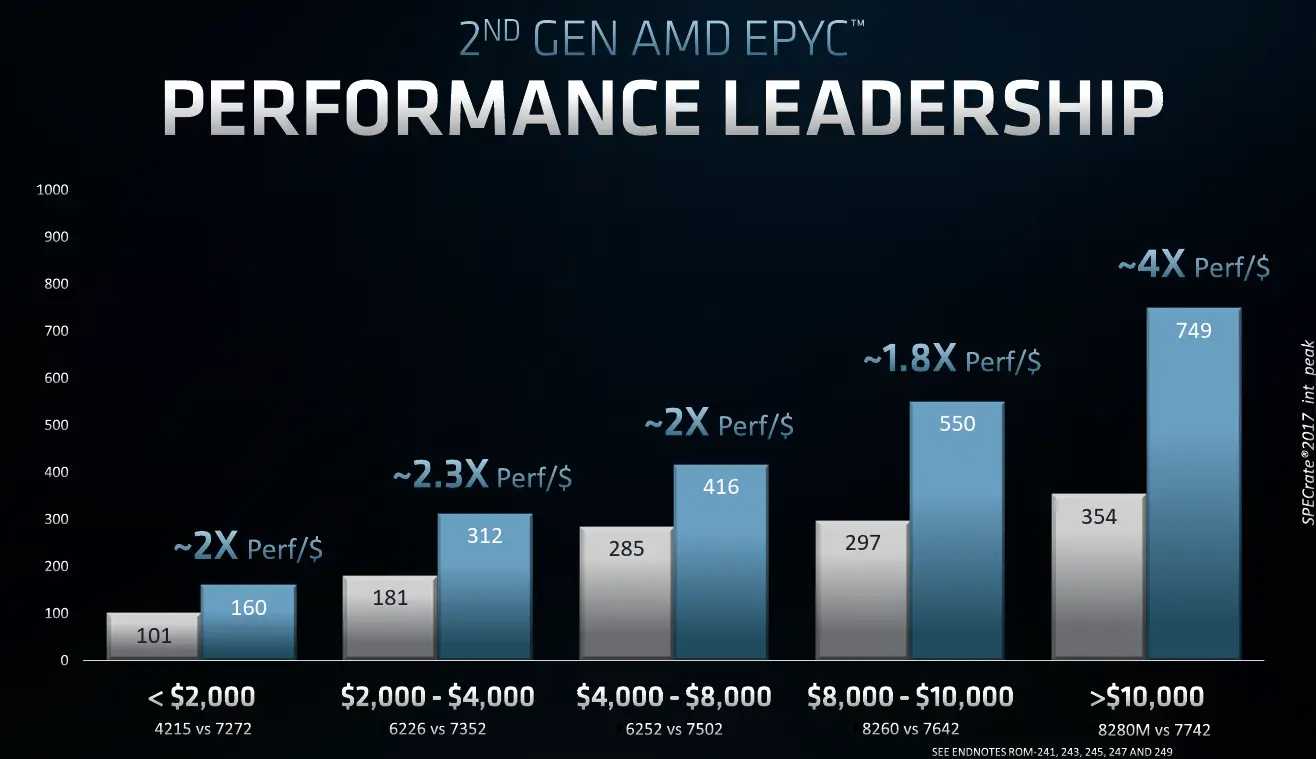Intel Refreshes 2nd Gen Xeon Scalable, Slashes Prices
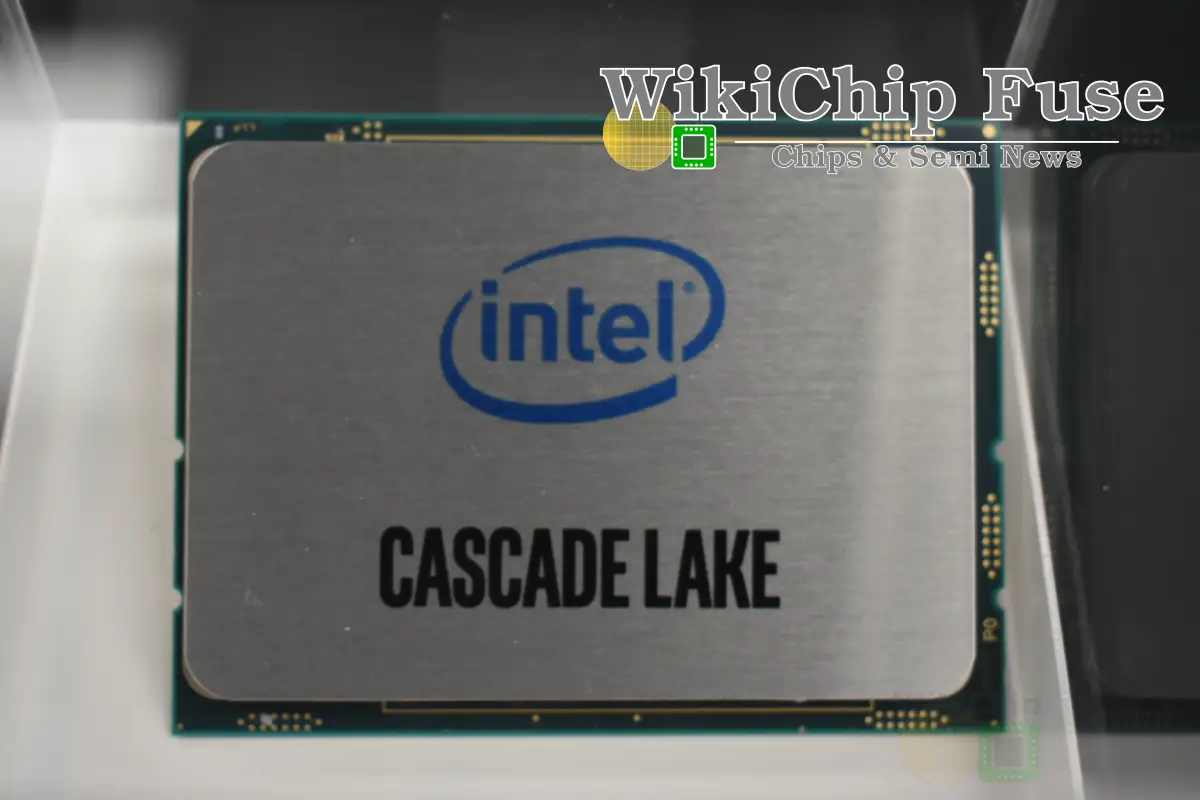
This week Intel is launching a refresh of its second-generation Xeon Scalable processors based on the Cascade Lake microarchitecture. This launch represents Intel’s most aggressive pricing restructure in well over a decade. This release is quite unusual for a number of reasons. The original Cascade Lake SP series was launched in April 2019. This launch is taking place just 10 months later – in what would normally be mid-cycle launch. This launch is taking place just a few months before Intel is expected to launch Cooper Lake which is expected to follow by Ice Lake server parts much later in the year. But between the original Cascade Lake launch and this refresh, AMD introduced Rome which brought considerable uplift in single-thread performance as well as core count thereby increasing the competitive pressure on Intel parts. Introducing a new platform takes time and heading into mid-2020, it looks like Rome has managed to make enough impact to realign their server portfolio to the current data center climate.
Cascade Lake R
While Intel is calling this announcement a ‘portfolio enhancement’, as you will see it’s a full-scale rollout. In total, Intel is releasing 19 new SKUs today, 16 are technically part of the Cascade Lake refresh rollout while three more are filling some of the gaps from the original launch. Without further ado here is the complete list of new SKUs.
| Cascade Lake Refresh SKUs | |||||||
|---|---|---|---|---|---|---|---|
| Model | Cores | Base (Bins) | Turbo (Bins) | Cache (MiB) | TDP (W) | Optane DC | 1K Price |
| Xeon Gold 6200 Series | |||||||
| Gold 6258R | 28 | 27 | 40 | 38.50 | 205 | Yes | $3,950 |
| Gold 6256 | 12 | 36 | 45 | 33.00 | 205 | Yes | $3,900 |
| Gold 6250 | 8 | 39 | 45 | 35.75 | 185 | Yes | $3,400 |
| Gold 6250L | 8 | 39 | 45 | 35.75 | 185 | Yes | $6,404 |
| Gold 6248R | 24 | 30 | 40 | 35.75 | 205 | Yes | $2,700 |
| Gold 6246R | 16 | 34 | 41 | 35.75 | 205 | Yes | $3,286 |
| Gold 6242R | 20 | 31 | 41 | 35.75 | 205 | Yes | $2,529 |
| Gold 6240R | 24 | 24 | 40 | 35.75 | 165 | Yes | $2,445 |
| Gold 6238R | 28 | 22 | 40 | 38.50 | 165 | Yes | $2,612 |
| Gold 6230R | 26 | 21 | 40 | 35.75 | 150 | Yes | $1,894 |
| Gold 6226R | 16 | 29 | 39 | 22.00 | 150 | Yes | $1,300 |
| Gold 6208U | 16 | 29 | 39 | 22.00 | 150 | Yes | $989 |
| Xeon Gold 5200 Series | |||||||
| Gold 5220R | 24 | 22 | 40 | 35.75 | 150 | Yes | $1,555 |
| Gold 5218R | 20 | 21 | 40 | 27.50 | 125 | Yes | $1,273 |
| Xeon Silver 4200 Series | |||||||
| Silver 4215R | 8 | 32 | 40 | 11.00 | 130 | Yes | $749 |
| Silver 4214R | 12 | 24 | 35 | 16.50 | 100 | Yes | $694 |
| Silver 4210R | 10 | 24 | 32 | 13.75 | 100 | Yes | $501 |
| Silver 4210T | 10 | 23 | 32 | 13.75 | 95 | No | $554 |
| Xeon Bronze 3200 Series | |||||||
| Bronze 3206R | 8 | 19 | 19 | 11.00 | 85 | No | $306 |
The R Suffix Fine Print
As is often the case with Intel’s naming scheme, things start out fairly straightforward but as new generations are introduced, new extensions follow and the SKU list grows in complexity. This round is no different. The R-suffixed SKUs are quite attractive from almost every spec – except one. Whereas the previous Xeon Gold Scalable families support 4-way SMP through 3 UPI links, the new R-suffixed SKUs only support 2-way SMP through 2 UPI links. In other words, the new Cascade Lake R SKUs do not replace the old SKUs but rather add much more competitive mainstream server processors. This segmentation is reminiscent of Intel’s old Xeon E5 and E7 families. Though much of the market uses single-socket and dual-socket servers, the small portion of the server (and a very lucrative segment) will have to pay a small “tax” by going to the more expensive Xeon Platinum or the previous Xeon Gold parts that do offer 4-way and 8-way SMP.
More Cores, Major Price Cut
The flow diagram below visually highlights what’s going on with the new parts. To simplify things a little, the diagram assumes that you use single-socket and dual-socket configuration. As you will see, this is also the same assumption Intel made with the new SKUs. What should be immediately obvious is that there are no new Xeon Platinum ‘R’ parts because there is no reason for them. With the exception of the 240-watt Platinum 8284, all the high core-count top-bin processors are now offered as Xeon Gold ‘R’ parts. Some parts such as the Gold 6248R are even binned higher than their older Xeon Platinum counterparts. More importantly, those new Xeon Gold ‘R’ parts literally cost a fraction of the previous Xeon Platinum processors.
Another way to look at the new parts is based on their model number. Given any two identical Xeon Gold models (with and without ‘R’), the new models come with more cores and always similar or better frequency, thereby improving the overall performance per dollar. For most of those SKUs Intel also significantly reduced the pricing. For most mainstream servers, this is a major cost restructuring move.
The biggest beneficiaries of the new processors are those the are looking for the top SKUs. Take a look at the 24-core and 28-core top-of-the-line parts. Again, we are assuming customers here we previously buying the Xeon Platinum for 1P/2P nodes, therefore the two SKUs are identical. For the two top-end Xeon Gold 6258R and 6238R, the price cut is around 60%. For those 28-core parts, a dual-socket server now costs less than a single chip was previously. For the other Xeon Platinum and high-end Xeon Gold, the difference is 30-50%.
| Xeon Platinum vs Xeon Gold R | |||||||||
|---|---|---|---|---|---|---|---|---|---|
| Cores | Clock (B/T) | TDP | Model | Price | Model | Price | Δ Price | ||
| 28 | 2.70/4.00 GHz | 205 W | Platinum 8280 | $10,009 | ⇒ | Gold 6258R | $3,950 | -60.54% | |
| 28 | 2.20/4.00 GHz | 165 W | Platinum 8276 | $8,719 | ⇒ | Gold 6238R | $2,612 | -61.01% | |
The comparison to AMD is a little more interesting because AMD doesn’t support more than dual-socket. This allows Intel to charge extra for 4-way and 8-way SMP without cannibalizing sales from that capability to compete with AMD. When AMD launched second-generation EPYC (Rome) they published the following comparison. The point AMD was trying to get across was that they had an over 2x performance-per-dollar advantage. The new Xeon Gold R SKUs can easily be substituted instead of the previous SKUs in order to get similar or better performance at much lower prices. We can use that comparison as a rough gauge of how well the new chips compare.
Whereas previously AMD claimed to have 1.82x perf/$ advantage with the EPYC 7642 vs the Platinum 8260, you can now substitute the 6240R which has identical specs with a 100 MHz higher turbo. Compared to the Platinum 8260 which has a price of $4702, the 6240R costs $2445 or about half price. Using the SPEC scores quoted by AMD on their slide, the change means the 6240R is about 10% more attractive in terms of perf/$. Likewise, if we do the same thing with the mid-range comparison where AMD is comparing the Gold 6252 to the EPYC 7502, the advantage was even bigger with 2.05x perf/$. If we substitute the Gold 6252 with the Gold 5220R which has a similar core count but 100 MHz higher base and 300 MHz higher turbo, the price drops from $3,655 to $1,555 or about a 60% reduction. Plugging in AMD’s own numbers and the previous 2.05x perf/$ advantage for AMD becomes 1.2x perf/$ advantage for Intel.
High-Memory SKUs
This refresh comes just a few weeks after Intel quietly re-adjusted the high-memory lineup. When Cascade Lake originally launched, Intel introduced two new high-memory designators: M and L. The medium-size M-suffixed SKUs indicated medium-size memory support of up to 2 TiB of memory whereas the L-suffixed SKUs indicated large-memory support of 4.5 TiB. In Late January Intel discontinued all the M SKUs and replaced the pricing of the L SKUs with the respective M. This is a big deal since the memory ‘tax’ is causing self inflicting-injuries. Intel has been promoting the use of Optane DC DIMMs for a number of years. However, instead of incentivizing customers to experiment with Optane DC DIMMs, the hefty memory ‘tax’ is causing customers to shy away.
Note that with the introduction of the new Gold 6250 (non-R SKU), Intel also introduced an equivalent Gold 6250L SKU.
| Xeon Scalable Large-Memory Support | |||
|---|---|---|---|
| Model | Old Price | New Price | Δ Price |
| Platinum 8280L | $17,906 | $13,012 | -27.33% |
| Platinum 8276L | $16,616 | $11,722 | -29.45% |
| Platinum 8260L | $12,599 | $7,705 | -38.84% |
| Gold 6250L | N/A (New) | $6,404 | N/A |
| Gold 6240L | $10,342 | $5,448 | -47.32% |
| Gold 6238L | $10,510 | $5,615 | -46.57% |
| Gold 5215L | $4,224 | $4,224 | 0% |
It took a little over half a year but it’s clear that competition from AMD Rome has finally made an impact on Intel’s Xeon lineup. Rome’s biggest impact is on the mainstream entry-level and mid-range SKUs which is where the new Xeon Gold R processors fit in. Intel even went as far as to offer identical specs as their top-of-the-line Xeon Platinum processors in dual-socket Xeon Gold R variants at a 60% discount. The large improvement in both price and performance-per-dollar is equivalent to the kind of benefits we have seen from a whole new generation of chips. It also suggests that when Cooper Lake is introduced, we will see the Xeon Platinum shifting over to higher core count. Both Cooper Lake and Ice Lake server parts are expected to launch for general availability around the same time as AMD 3rd generation EPYC (codename Milan).
Related Articles
- Xeon Gold – Intel
- Centaur Unveils Its New Server-Class x86 Core: CNS; Adds AVX-512
- AMD’s New EPYC 7H12: A Specially-Binned HPC Processor
- A Look At The AMD Zen 2 Core
–
Spotted an error? Help us fix it! Simply select the problematic text and press Ctrl+Enter to notify us.
–


